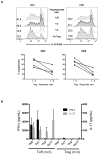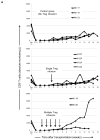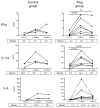Regulatory T Cell Infusion Can Enhance Memory T Cell and Alloantibody Responses in Lymphodepleted Nonhuman Primate Heart Allograft Recipients
- PMID: 26700196
- PMCID: PMC4919255
- DOI: 10.1111/ajt.13685
Regulatory T Cell Infusion Can Enhance Memory T Cell and Alloantibody Responses in Lymphodepleted Nonhuman Primate Heart Allograft Recipients
Abstract
The ability of regulatory T cells (Treg) to prolong allograft survival and promote transplant tolerance in lymphodepleted rodents is well established. Few studies, however, have addressed the therapeutic potential of adoptively transferred, CD4(+) CD25(+) CD127(-) Foxp3(+) (Treg) in clinically relevant large animal models. We infused ex vivo-expanded, functionally stable, nonselected Treg (up to a maximum cumulative dose of 1.87 billion cells) into antithymocyte globulin-lymphodepleted, MHC-mismatched cynomolgus monkey heart graft recipients before homeostatic recovery of effector T cells. The monkeys also received tacrolimus, anti-interleukin-6 receptor monoclonal antibodies and tapered rapamycin maintenance therapy. Treg administration in single or multiple doses during the early postsurgical period (up to 1 month posttransplantation), when host T cells were profoundly depleted, resulted in inferior graft function compared with controls. This was accompanied by increased incidences of effector memory T cells, enhanced interferon-γ production by host CD8(+) T cells, elevated levels of proinflammatory cytokines, and antidonor alloantibodies. The findings caution against infusion of Treg during the early posttransplantation period after lymphodepletion. Despite marked but transient increases in Treg relative to endogenous effector T cells and use of reputed "Treg-friendly" agents, the host environment/immune effector mechanisms instigated under these conditions can perturb rather than favor the potential therapeutic efficacy of adoptively transferred Treg.
Keywords: T cell biology; animal models: nonhuman primate; basic (laboratory) research/science; heart transplantation/cardiology; immune regulation; immunobiology; lymphocyte biology; translational research/science.
© Copyright 2015 The American Society of Transplantation and the American Society of Transplant Surgeons.
Conflict of interest statement
The authors of this manuscript have no conflicts of interest to disclose as described by the American Journal of Transplantation.
Figures














Comment in
-
Regulating T Cell Behavior.Am J Transplant. 2016 Jul;16(7):1949-50. doi: 10.1111/ajt.13724. Epub 2016 Mar 17. Am J Transplant. 2016. PMID: 26792650 No abstract available.
Similar articles
-
Ex Vivo Expanded Donor Alloreactive Regulatory T Cells Lose Immunoregulatory, Proliferation, and Antiapoptotic Markers After Infusion Into ATG-lymphodepleted, Nonhuman Primate Heart Allograft Recipients.Transplantation. 2021 Sep 1;105(9):1965-1979. doi: 10.1097/TP.0000000000003617. Transplantation. 2021. PMID: 33587433 Free PMC article.
-
Impact of Human Mutant TGFβ1/Fc Protein on Memory and Regulatory T Cell Homeostasis Following Lymphodepletion in Nonhuman Primates.Am J Transplant. 2016 Oct;16(10):2994-3006. doi: 10.1111/ajt.13883. Epub 2016 Jul 11. Am J Transplant. 2016. PMID: 27217298 Free PMC article.
-
Sequential monitoring and stability of ex vivo-expanded autologous and nonautologous regulatory T cells following infusion in nonhuman primates.Am J Transplant. 2015 May;15(5):1253-66. doi: 10.1111/ajt.13113. Epub 2015 Mar 17. Am J Transplant. 2015. PMID: 25783759 Free PMC article.
-
Advances on Non-CD4 + Foxp3+ T Regulatory Cells: CD8+, Type 1, and Double Negative T Regulatory Cells in Organ Transplantation.Transplantation. 2015 Aug;99(8):1553-9. doi: 10.1097/TP.0000000000000813. Transplantation. 2015. PMID: 26193065 Free PMC article. Review.
-
Regulatory dendritic cells for promotion of liver transplant operational tolerance: Rationale for a clinical trial and accompanying mechanistic studies.Hum Immunol. 2018 May;79(5):314-321. doi: 10.1016/j.humimm.2017.10.017. Epub 2017 Oct 31. Hum Immunol. 2018. PMID: 29100944 Free PMC article. Review.
Cited by
-
Characterization, biology, and expansion of regulatory T cells in the Cynomolgus macaque for preclinical studies.Am J Transplant. 2019 Aug;19(8):2186-2198. doi: 10.1111/ajt.15313. Epub 2019 Mar 29. Am J Transplant. 2019. PMID: 30768842 Free PMC article.
-
Translational impact of NIH-funded nonhuman primate research in transplantation.Sci Transl Med. 2019 Jul 10;11(500):eaau0143. doi: 10.1126/scitranslmed.aau0143. Sci Transl Med. 2019. PMID: 31292263 Free PMC article. Review.
-
Cell therapy in vascularized composite allotransplantation.Biomed J. 2022 Jun;45(3):454-464. doi: 10.1016/j.bj.2022.01.005. Epub 2022 Jan 15. Biomed J. 2022. PMID: 35042019 Free PMC article. Review.
-
Interleukin-35 mitigates the function of murine transplanted islet cells via regulation of Treg/Th17 ratio.PLoS One. 2017 Dec 13;12(12):e0189617. doi: 10.1371/journal.pone.0189617. eCollection 2017. PLoS One. 2017. PMID: 29236782 Free PMC article.
-
Cellular therapies in organ transplantation.Transpl Int. 2021 Feb;34(2):233-244. doi: 10.1111/tri.13789. Epub 2021 Jan 15. Transpl Int. 2021. PMID: 33207013 Free PMC article. Review.
References
-
- Bluestone JA, Thomson AW, Shevach EM, Weiner HL. What does the future hold for cell-based tolerogenic therapy? Nat Rev Immunol. 2007;7(8):650–654. - PubMed
-
- Wood KJ, Bushell A, Hester J. Regulatory immune cells in transplantation. Nat Rev Immunol. 2012;12(6):417–430. - PubMed
-
- Juvet SC, Whatcott AG, Bushell AR, Wood KJ. Harnessing regulatory T cells for clinical use in transplantation: the end of the beginning. Am J Transplant. 2014;14(4):750–763. - PubMed
Publication types
MeSH terms
Substances
Grants and funding
LinkOut - more resources
Full Text Sources
Other Literature Sources
Medical
Research Materials

